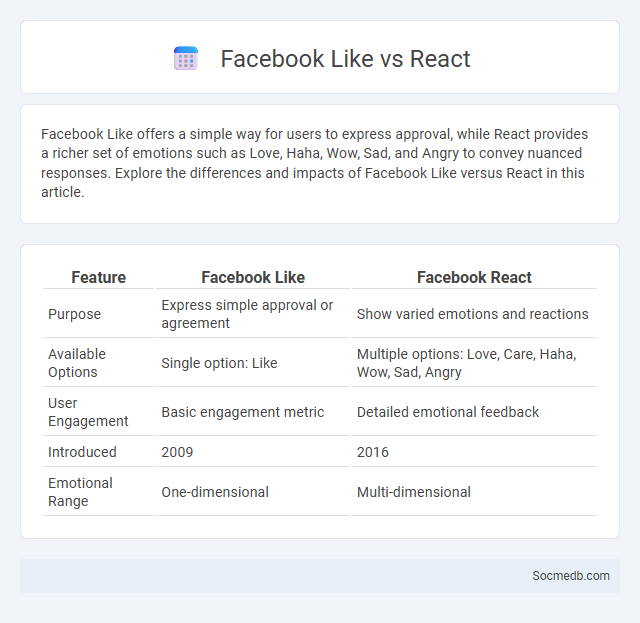
Photo illustration: Facebook Like vs React
Facebook Like offers a simple way for users to express approval, while React provides a richer set of emotions such as Love, Haha, Wow, Sad, and Angry to convey nuanced responses. Explore the differences and impacts of Facebook Like versus React in this article.
Table of Comparison
| Feature | Facebook Like | Facebook React |
|---|---|---|
| Purpose | Express simple approval or agreement | Show varied emotions and reactions |
| Available Options | Single option: Like | Multiple options: Love, Care, Haha, Wow, Sad, Angry |
| User Engagement | Basic engagement metric | Detailed emotional feedback |
| Introduced | 2009 | 2016 |
| Emotional Range | One-dimensional | Multi-dimensional |
Understanding Facebook Like: Definition and Purpose
A Facebook Like represents a user's interaction with content, signaling approval, interest, or agreement through a simple click on the Like button. This engagement metric boosts content visibility in the Facebook algorithm, increasing reach and fostering community interaction. Brands and individuals leverage Likes to gauge audience sentiment, measure post performance, and enhance social media strategies effectively.
What Are Facebook Reactions?
Facebook Reactions are a set of emoji-based responses that allow users to express a range of emotions beyond the traditional "Like" button, including Love, Haha, Wow, Sad, and Angry. These reactions help gauge audience sentiment more accurately by providing nuanced feedback on posts, comments, and photos. Introduced in 2016, Facebook Reactions enhance user interaction and engagement metrics for personal profiles, business pages, and advertisers.
The Evolution of Facebook Like and React
Facebook's Like button, introduced in 2009, revolutionized user interaction by enabling quick expressions of approval, evolving into a more nuanced reaction system in 2016 that includes Love, Haha, Wow, Sad, and Angry emojis. This expansion allowed users to convey a broader range of emotions, enhancing engagement metrics and providing advertisers with deeper insights into audience sentiment. The evolution of Facebook Reactions reflects the platform's ongoing commitment to user experience and emotional connectivity in social media communication.
Key Differences: Like vs React on Facebook
Likes on Facebook provide a simple, quick way for You to show approval or enjoyment of a post, serving as a basic form of positive feedback. Reacts extend beyond likes by offering a range of emotions including love, laughter, surprise, sadness, and anger, enabling You to express more nuanced feelings. These differences make reacts more versatile for social interactions and help content creators gauge audience sentiment with greater precision.
User Engagement: Do Reactions or Likes Matter More?
User engagement on social media hinges on both reactions and likes, but reactions provide deeper insights into audience sentiment by capturing emotions beyond simple approval. Likes signal general popularity and boost visibility, while reactions like love, anger, or sadness allow you to gauge how your content resonates on a more nuanced level. Understanding which metric matters more depends on your goals, with reactions offering a richer data set to tailor your content strategy effectively.
Impact on Facebook Algorithms: Reacts vs Likes
Facebook algorithms prioritize reaction types differently, with "Reacts" generating stronger engagement signals than standard "Likes." Users who interact through varied reactions such as Love, Haha, or Angry influence content visibility by signaling nuanced emotional responses. This deeper engagement helps Facebook tailor feeds more accurately, increasing the likelihood of content being promoted to broader audiences.
Emotional Expression: The Power of Facebook Reactions
Facebook Reactions offer users a nuanced, emotionally rich way to engage with content, expanding beyond the traditional "like" to include Love, Haha, Wow, Sad, and Angry responses. These reaction options enable more precise emotional expression, fostering deeper connections and more meaningful interactions across personal and brand posts. Analyzing reaction data also provides valuable insights into audience sentiment, helping marketers and content creators tailor strategies for enhanced engagement.
Social Influence: Perception of Likes vs Reacts
Social influence on social media is significantly shaped by how users perceive Likes versus Reacts, with Reacts offering a broader range of emotional expressions that can enhance engagement and authenticity. Your audience may interpret Reacts as more meaningful feedback compared to Likes, which are often seen as less expressive or generic approvals. Optimizing content to encourage varied Reacts can improve your social media strategy by fostering deeper user connections and more accurate measurement of influence.
Business Insights: Measuring Audience Sentiment
Measuring audience sentiment on social media provides critical business insights by analyzing emotions and opinions expressed in comments, reviews, and posts using natural language processing tools. Sentiment analysis helps brands identify customer satisfaction levels, monitor product reception, and detect emerging trends in real-time. Leveraging these insights enhances marketing strategies, improves customer engagement, and drives data-informed decision-making for improved business outcomes.
Best Practices: Using Facebook Likes and Reactions Strategically
Leveraging Facebook Likes and Reactions strategically enhances your content's visibility and engagement by signaling audience sentiment to the algorithm. You should tailor your posts to encourage specific reactions that align with your brand's message, such as "Love" for heartfelt campaigns or "Haha" for humorous content, boosting organic reach. Monitoring these interactions provides valuable insights into your audience's preferences, enabling you to refine your social media strategy effectively.
 socmedb.com
socmedb.com